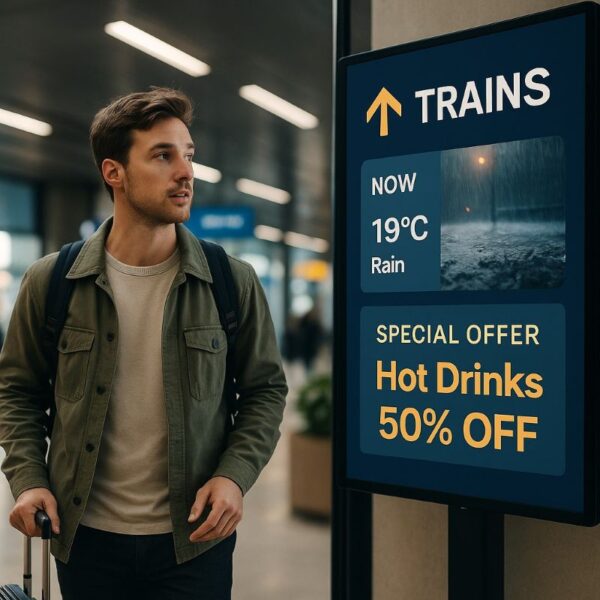A traveler lands after a thirteen-hour flight. They’ve left behind daylight, stepped into the night, and still have another train or flight ahead. In that moment, they’re not looking for inspiration. They’re looking for clarity. For efficiency. For something human.
In the fast-paced world of travel retail, every second matters. Technology can no longer be just functional. It must be useful — and sensitive. Capable of reading what’s happening around it and responding in real time. In 2025, digital signage is no longer a tool for broadcasting. It’s a system that thinks. And thinks about how to connect with people.
From Static Display to Contextual Intelligence
For years, digital signage was viewed as a visual channel to run pre-programmed promotions. A modern-day poster. But that’s no longer enough. Today’s screens do more than display. They listen. They observe. They learn.
Powered by AI and real-time data analysis, digital signage becomes a living layer that adapts to its surroundings and to the traveler. It can recognize flows, time patterns, consumer profiles—even mood. And from that constant reading, it can adjust the message, the tone, the suggested route, or even the language.
Personalization at the moment of need means offering the right content to the right person at the right time. In stations and airports with hundreds of thousands of daily movements, that kind of precision translates into tangible impact: better experiences, higher conversions, and bigger average tickets.
It’s not about Screens. It’s about Systems that Understand
When we talk about digital signage in transport hubs, we’re not talking about isolated displays. We’re talking about designing frictionless journeys. About supporting people with different needs and tight schedules. People who can’t afford to waste time.
A well-integrated system can reduce queues, offer alternatives, guide someone to the nearest accessible lift, or instantly switch languages based on who’s in front of the screen. All of it hands-free — because the screen already knows what’s needed.
In this setting, where every minute counts, contextual intelligence makes the difference. Screens can connect with systems tracking foot traffic, weather, inventory, or urban mobility. They can promote hot drinks when it rains. Detect platform crowding and redirect flows. Or suggest a nearby service tailored to that traveler’s profile. All in real time. Without friction.
Travelers are Already Experiencing It
At El Prat Airport in Barcelona, SELF has launched as the first fully robotic restaurant. The customer orders from a screen, pays contactless, and watches a robotic arm serve their meal with precision. No lines. No errors. No friction.
What does the traveler gain? Time, control, comfort. What does the operator gain? Optimized flow, shorter queues, higher sales. A clear win-win. It’s a perfect example of how AI applied to physical spaces is no longer a promise, but a working reality. And how technology, when paired with a well-designed experience, multiplies its value.
Another strong example is On Your Way, the first autonomous store in a Spanish airport, operated by AREAS. It merges digital signage, self-service and real-time promotions in a single interactive retail space. At the same time, e-paper displays are quietly gaining ground. They don’t shine or animate — and that’s the point. They mimic the look of paper, consume barely any energy, and are replacing posters, signs, and boards without being noticed. This is digital signage that blends in. And that subtlety is transformative too.
Content that Travels with the Traveler
A traveler’s journey is rarely linear. They arrive, wait, move, decide, wait again. What if digital content followed that flow like chapters in a story? Directional signage on arrival. Immersive content during dwell time. Personalized offers just before boarding. Everything connected. Everything with purpose.
That requires systems capable of thinking in real time. CMS platforms connected to sensors, cameras, inventory, weather feeds. If it’s raining—suggest a warm drink. If flow slows down—offer an alternate route. If stress is detected—lower the pace of the visuals. Because when seconds matter, the screen must act before the traveler even knows what they need.
Don’t just React — Propose
The real power of digital signage isn’t in how it reacts. It’s in what it suggests. More efficient routes. Relevant product placements at just the right moment. Impulse purchases that feel natural, not forced.
It’s not about showing more. It’s about showing better. And doing it at exactly the right point in the journey. In travel retail, that kind of timing becomes a competitive edge.
Digital Empathy: The Next Frontier
The real leap forward in digital signage isn’t technical — it’s emotional. Systems are emerging that not only adapt to external factors but also anticipate how the traveler feels. Using ambient sensors, non-invasive biometrics, or micro-gesture analysis, these systems can detect stress, fatigue or frustration—and respond accordingly. Softer music. Clearer guidance. Shorter routes.
Screens stop being one-way devices. They become empathetic interfaces.
That’s the qualitative shift. Not to impact more, but to care better. To be present without being pushy. To offer value without demanding attention. When technology becomes empathetic, it improves not only the experience — but the relationship.
When the Screen Understands, the Journey Improves
Many still see digital signage as just another display. But when designed intelligently, it becomes a companion. Not just something that informs, but something that supports. That doesn’t just optimize logistics, but enhances how the traveler feels along the way.
Because a screen that simply broadcasts is a tool. But one that listens, thinks, and responds—that’s an ally. For the traveler. And for the business.
Mónica Fernández Bové is the managing director of nsign.tv, a digital signage platform focused on simplifying content management and integration. With over 20 years of experience in finance and digital enterprises, she has held senior leadership roles in the financial and technology sectors. She has also founded and managed companies across technology, services, and industrial fields, launching accelerators and venture builders to drive innovation. Fernández Bové holds degrees in Economics and Business Administration, Political Science and Sociology, and an Executive MBA from ESADE. At nsign.tv, she leads efforts to scale and enhance digital communication solutions for businesses worldwide.





